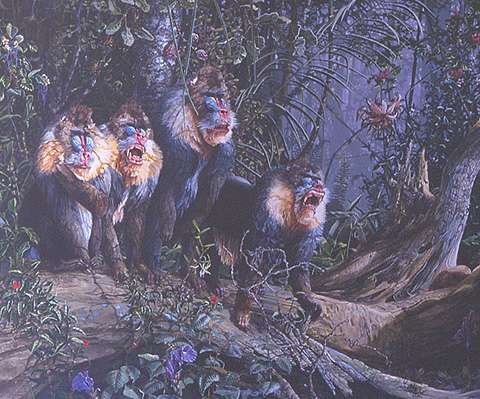The First Phalanx
-- Mandrills (1990)

Acrylic on
illustration board
20" x 30"
| Few
animals are as striking as an old male mandrill (Mandrillus
sphinx), his subtly vermiculated dark body contrasting handsomely
with blazing orange shoulder patches. The male's huge size (in
this no other monkey exceeds him), powerful build and intimidating
canines suggest a brutal machismo that is amplified by a gaudy
face, itself an overt phallic symbol. Mandrills have a fairly
restricted distribution in Gabon, Rio Muni, Congo (that's the
original Congo) and Cameroon southeast of the Sanaga River,
which divides their range from that of their close relative,
the drill (M. leucophaeus). They normally travel in groups
of a dozen or so females and young which are led by a single
adult male, and these "harems" function within a larger
community of other small parties and bachelor males. Occasionally
a number of these groups will merge into a large temporary herd
led by a coalition of alpha males. Here four old males display
threats of varying intensity toward an unseen adversary. The
Central African setting is occupied as well by female mandrills,
a running frog (Kassina sp.), a Harris rose beetle (Megalorrhina
harrisii), a swallowtail butterfly (Papilio sp.),
and a millipede (Spirobolus sp.). When I painted this
I didn't take into account that this "herding" of mandrills
only seems to happen during the dry season, a time of year when
the kind of blossoming I depicted doesn't really happen . . .
but it looks nice, anyway. |
|